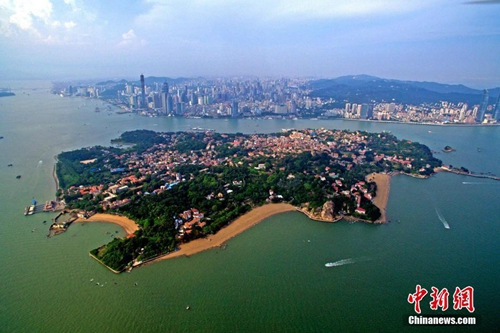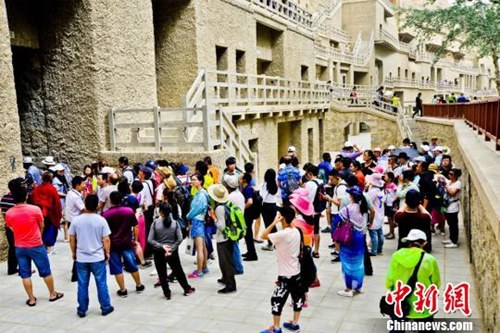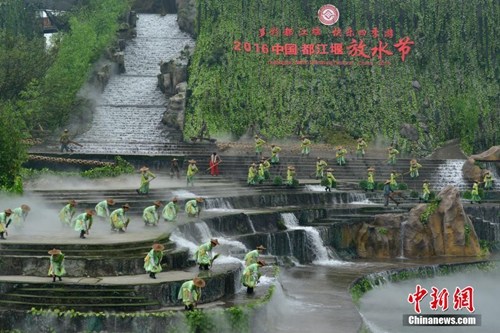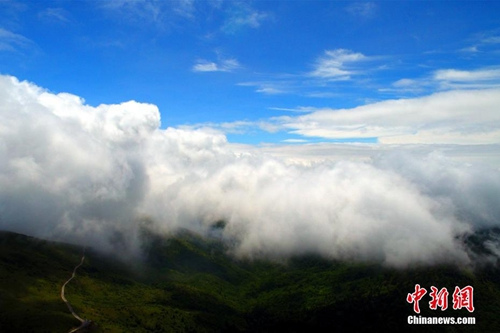
BEIJING, Beijing, July 4 (Shangguan Yun) According to media reports, from July 2 to 12, the World Heritage Conference will be held in Poland, and Hoh Xil in Qinghai and Gulangyu in Fujian will sprint the world natural heritage and cultural heritage respectively. Previously, the total number of world heritages in China has reached 50, including natural heritage and cultural landscape, which are either magnificent or profound. So, how many of these 50 amazing world heritages do you know?
In 1977, the World Heritage Committee held its first general meeting in Paris, France. On December 12th, 1985, China acceded to the Convention for the Protection of the World Cultural and Natural Heritage. In 1987, China’s Great Wall, Mogao Grottoes, Ming and Qing palaces, Qin Shihuang’s Mausoleum and Terracotta Warriors Pit, and Zhoukoudian Peking Man Site were also included in the World Heritage List.

Needless to say, the Mogao Grottoes are also known as the Thousand-Buddha Cave in the above-mentioned list of China’s first batch of World Heritage sites. It is said that it was built in the pre-Qin period, with 735 caves and 45,000 square meters of murals, which makes visitors who have seen the real thing amazed. Shu Lang’s "flying" is a business card of Dunhuang Mogao Grottoes; The grandeur of the Great Wall has also left a strong mark on the world heritage.
Ancient cities and villages are also places worth visiting among these 50 world heritages. Like Pingyao Ancient City, it is located in Pingyao County in the middle of Shanxi Province, and was built in the period of Western Zhou Xuanwang (827-782 BC). Pingyao, Shanxi Province is known as one of the "four best preserved ancient cities". The residential buildings in the ancient city have strict layout, clear axis, exquisite wood carving, brick carving and stone carving with strong local flavor and paper-cut window grilles, which are vivid and lifelike.

The completion of Dujiangyan has made the Chengdu Plain "flood and drought come from people, I don’t know hunger, there is no famine, and the world is called abundance". This is a description of Dujiangyan in Historical Records, from which we can see the importance of this ancient water conservancy project. At the 24th General Assembly of the United Nations World Heritage Committee in 2000, "Qingcheng Mountain — Dujiangyan is listed in the World Heritage List.
Dujiangyan was built in the 3rd century BC. It was a large-scale water conservancy project built by Li Bing, the prefect of Shu County of Qin State, and his sons during the Warring States Period. It is the oldest and only preserved water conservancy project in the world, characterized by water diversion without dams. For more than 2,200 years, it still plays a great role, and is called "the great masterpiece of the civilized world".
Shennongjia, a world natural heritage in Hubei, shows us another landscape. In many people’s minds, Shennongjia is famous for the legend of "Shennong teaches people to cultivate crops and taste a hundred herbs", and the Shennong altar is still preserved in the scenic spot. It is reported that there are 3767 species of vascular plants in Shennongjia Heritage Site, more than 600 species of vertebrates have been recorded, and 4365 species of insects have been found. Among them, there are 205 endemic species, 2 endemic genera and 1793 endemic species in China, and the number of the flagship species Shennongjia golden monkey is more than 1300.

Why can Shennongjia be selected as a World Heritage Site? The World Heritage Committee gave the answer: Shennongjia, Hubei Province is unique in the world in terms of biodiversity, zonal vegetation types, vertical natural belt spectrum, ecology and biological processes. In particular, its biodiversity makes up for the blank in the world heritage list.
Yin Ruins and Fujian Tulou … … It is possible that there will be more and more world heritage sites in China in the future. In fact, whether it is natural landscape or cultural heritage, when they are selected into the World Heritage, it does not mean that they will be protected and utilized once and for all, but on the basis of the original, so that these precious heritages can exist forever with a beautiful attitude. (End)
Appendix: World Heritage of China (from official website, State Administration of Cultural Heritage, until July 3, 2017)
Forbidden City in Ming and Qing Dynasties (Beijing Forbidden City, Shenyang Forbidden City)
Qin Shihuang Mausoleum and Terracotta Warriors Pit
Mogao Grottoes
Mount Tai
Zhoukoudian Peking Man Site
the Great Wall
Mount Huangshan
huanglong scenic and historic interest area
Jiuzhaigou scenic spot
wulingyuen scenik and historik interest area
ancient building complex in the wu dang mountains
historic ensemble of the potala palace, lhasa
Chengde summer resort and its surrounding temples
Confucius Temple, Confucius Forest and Confucius House in Qufu
Lushan national park
Emei Mountain — Leshan Giant Buddha
Ancient City of Pingyao
The Classical Gardens of Suzhou
Old Town of Lijiang
Beijing Royal Garden-Summer Palace
Beijing Royal Altar — Temple of Heaven
Dazu rock carvings
Mount Wuyi
Ancient villages in southern Anhui-Xidi and Hongcun (2000)
imperial tombs of the ming and qing dynasties
Longmen Grottos
Qingcheng Mountain — Dujiangyan irrigation system
Yunnan Sanjiang Parallel Nature Reserve
capital cities and tombs of the ancient koguryo kingdom
Historic Centre of Macau
Sichuan giant panda habitat
Yin ruins
Kaiping Diaolou and Village
Karst in southern China
the Hakka earth buildings of Fujian
Sanqingshan National Park
Mount Wutai
china danxia landform
Dengfeng "in heaven and earth" historical site
Hangzhou West Lake Cultural Landscape
Chengjiang fossil site
the site of xanadu
Cultural Landscape of Hani Terrace in Honghe
Tianshan mountain, Xinjiang
Silk Road: The Road Network of Chang ‘an-Tianshan Corridor
Grand Canal
Tusi site
Yungang Grottoes
Zuojiang Huashan Rock Painting
Shennongjia
关于作者